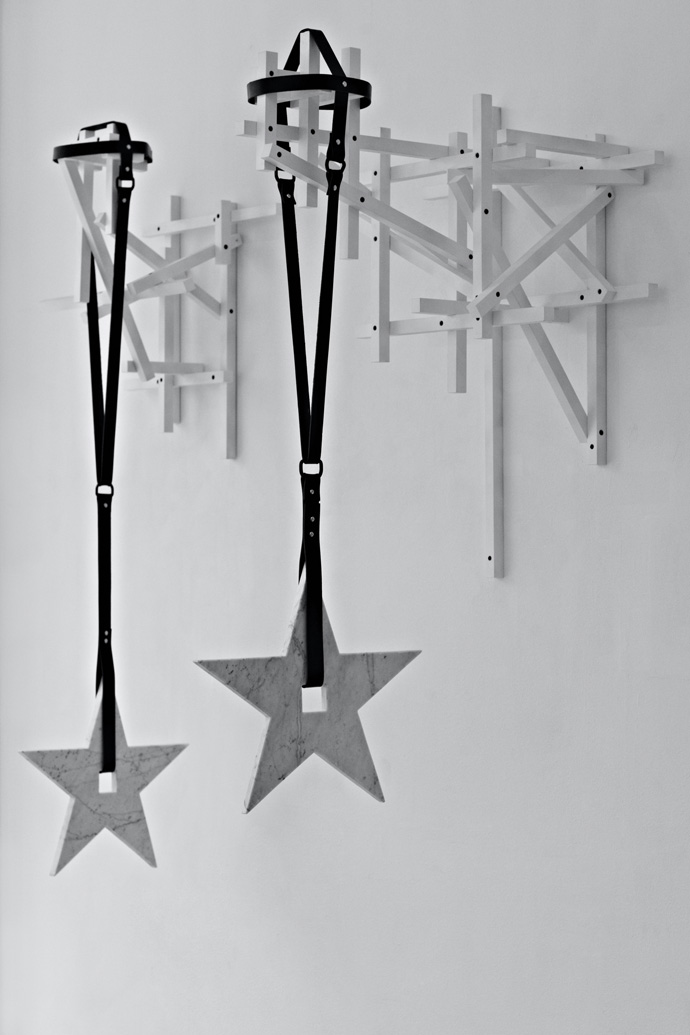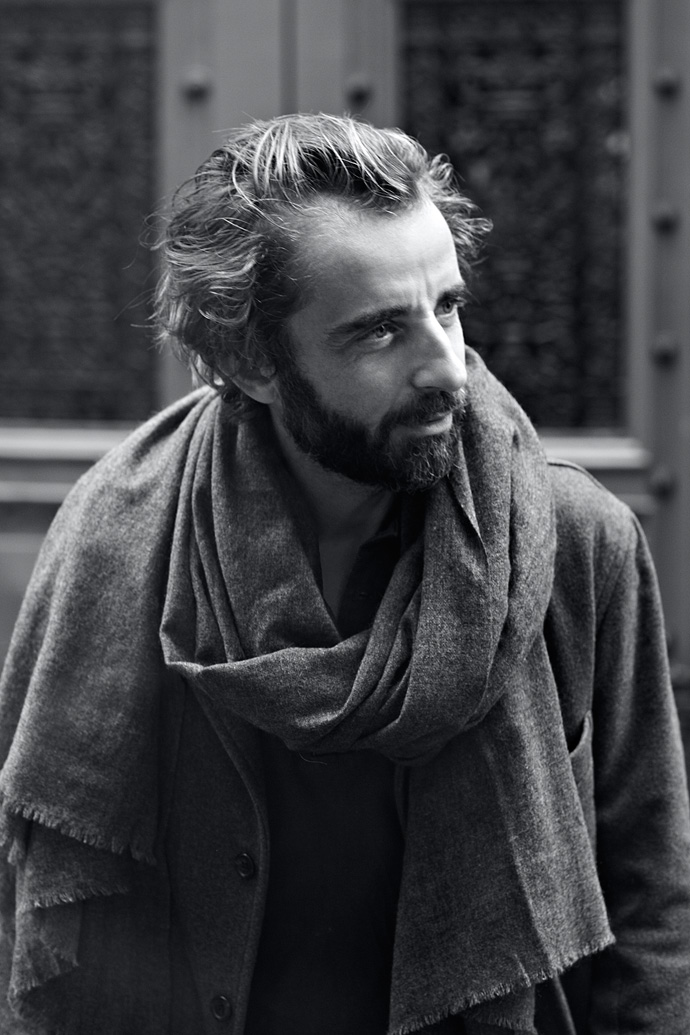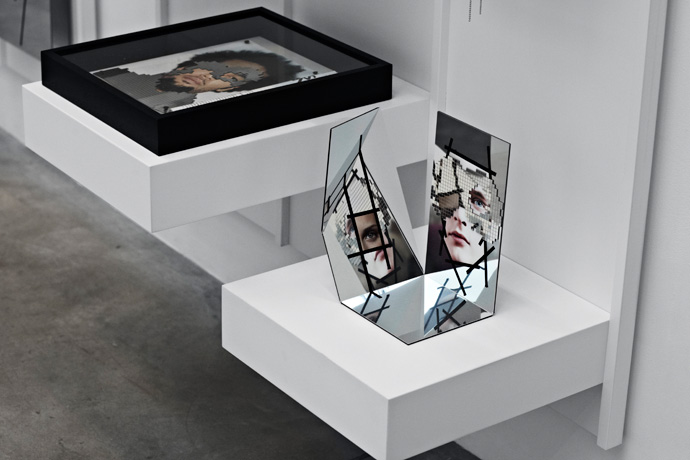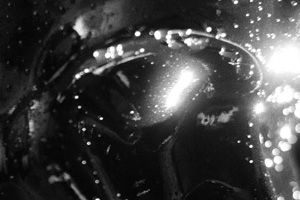-

marc turlan: STAR NOTORIOUS
-First, he covered them up with a resin mask, then he cut their eyes out, with a scalpel and after with a laser. This is not Dexter, this is artist Marc Turlan, who always finds new ways of torturing magazines.With his latest solo show EXO STAR he is taking an artistic leap, opening this saturday at Galerie Anne de Villepoix in Paris.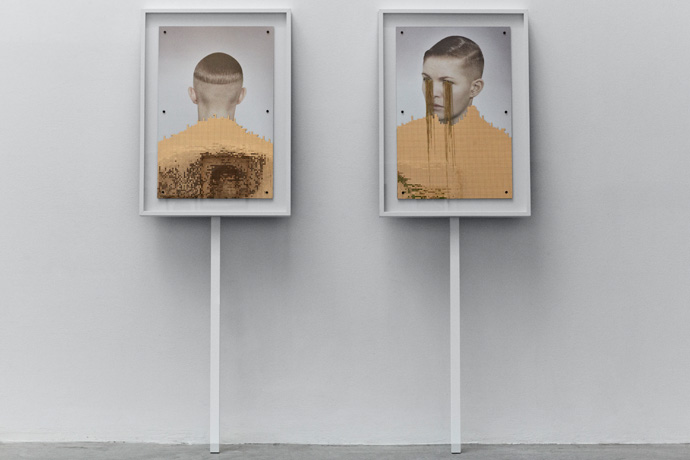 Marc Turlan: protest board 1 and 2, a collaboration with british photographer Timur Celikdag.
Courtesy gal Anne de VillepoixThe new sculptures of Marc Turlan conclude a logical extension of his appropriative work with the pages of glossy magazines:“The base of all i do is collage. The technique for my sculpture is the same way, it’s like 3 dimensional collages.”Right in the first room, the program for the exhibit gets clear: a gym workbench, weight bars in a stack, and 6 sheets of mirror, each with a word inscription of mirror mosaic, that serve as the commandments for this show: WORK – NOTORIETY – SINCERITY – POWER – LOVE
Marc Turlan: protest board 1 and 2, a collaboration with british photographer Timur Celikdag.
Courtesy gal Anne de VillepoixThe new sculptures of Marc Turlan conclude a logical extension of his appropriative work with the pages of glossy magazines:“The base of all i do is collage. The technique for my sculpture is the same way, it’s like 3 dimensional collages.”Right in the first room, the program for the exhibit gets clear: a gym workbench, weight bars in a stack, and 6 sheets of mirror, each with a word inscription of mirror mosaic, that serve as the commandments for this show: WORK – NOTORIETY – SINCERITY – POWER – LOVE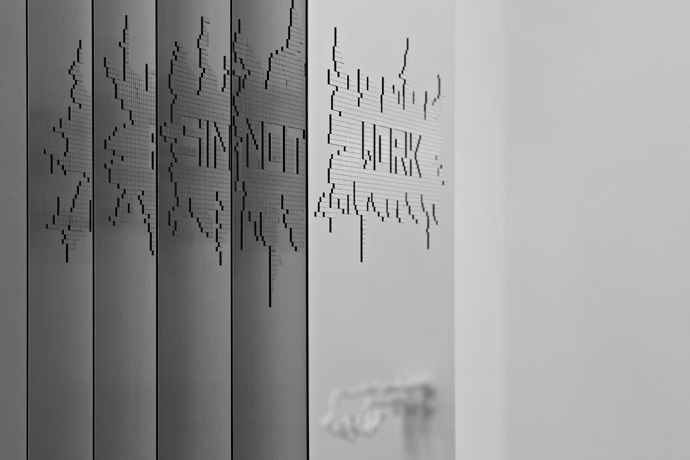 Marc Turlan: Statement Carpets. Courtesy gal Anne de Villepoix“It’s about the body. it’s erotic. Its a fetish to have in your mind to transform your body, to make a new image of yourself” he explains, next to two sculptures that look like snaffle headpieces with star shaped marble weights hanging from its leather thongs. It is inspired by gym gear to work your trapezius muscle. The materials surrounding us – leather, marble, mirror, wood. Marc Turlans recurrent structural elements are evident: eroticism, vanity, fetishism and notoriety.
Marc Turlan: Statement Carpets. Courtesy gal Anne de Villepoix“It’s about the body. it’s erotic. Its a fetish to have in your mind to transform your body, to make a new image of yourself” he explains, next to two sculptures that look like snaffle headpieces with star shaped marble weights hanging from its leather thongs. It is inspired by gym gear to work your trapezius muscle. The materials surrounding us – leather, marble, mirror, wood. Marc Turlans recurrent structural elements are evident: eroticism, vanity, fetishism and notoriety.Left: Marc Turlan's "Star Rack", and right: the artist himself
And there is of course, the star: “The star is the representation of the absolute, its a simple symbol for everyone. This desire, or fantasy to be recognised, to be famous, to arrive at this point… I use the star in marble.”In Marc Turlans “gym” you actually work out with the star as a marble weight, stemming the symbol of the desired recognition and thus transform yourself through and towards that idea.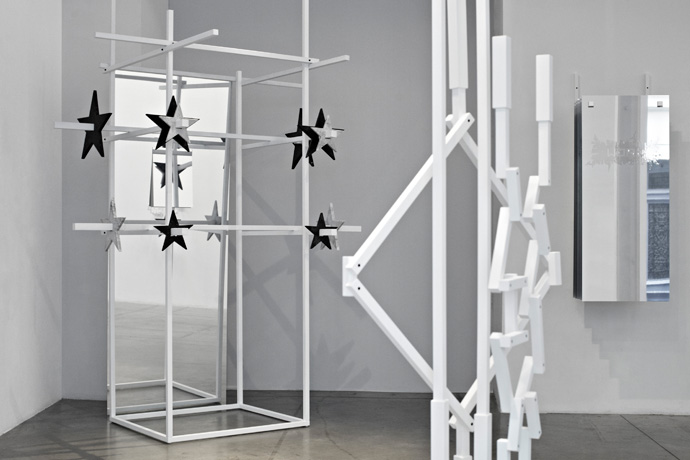 The first room of EXO STAR with "Home Star-Gym". Courtesy Gallery Anne de VillepoixThe second room is pitch black and only lit by pulsating light bulbs on a cluster of stars, an array of audio sculptures speak to the visitor with each a “collage sonore” (sound collage). Corresponding to the acoustic rework of a writers text hangs a framed object, containing a book of the same author with a mirror mosaic highlighting a sentence.“I keep a sentence very different to the audio collage. It is a proposition, an open invitation. I don’t work in an interactive way. I am interested in the object. It becomes a sculpture” he explains.
The first room of EXO STAR with "Home Star-Gym". Courtesy Gallery Anne de VillepoixThe second room is pitch black and only lit by pulsating light bulbs on a cluster of stars, an array of audio sculptures speak to the visitor with each a “collage sonore” (sound collage). Corresponding to the acoustic rework of a writers text hangs a framed object, containing a book of the same author with a mirror mosaic highlighting a sentence.“I keep a sentence very different to the audio collage. It is a proposition, an open invitation. I don’t work in an interactive way. I am interested in the object. It becomes a sculpture” he explains.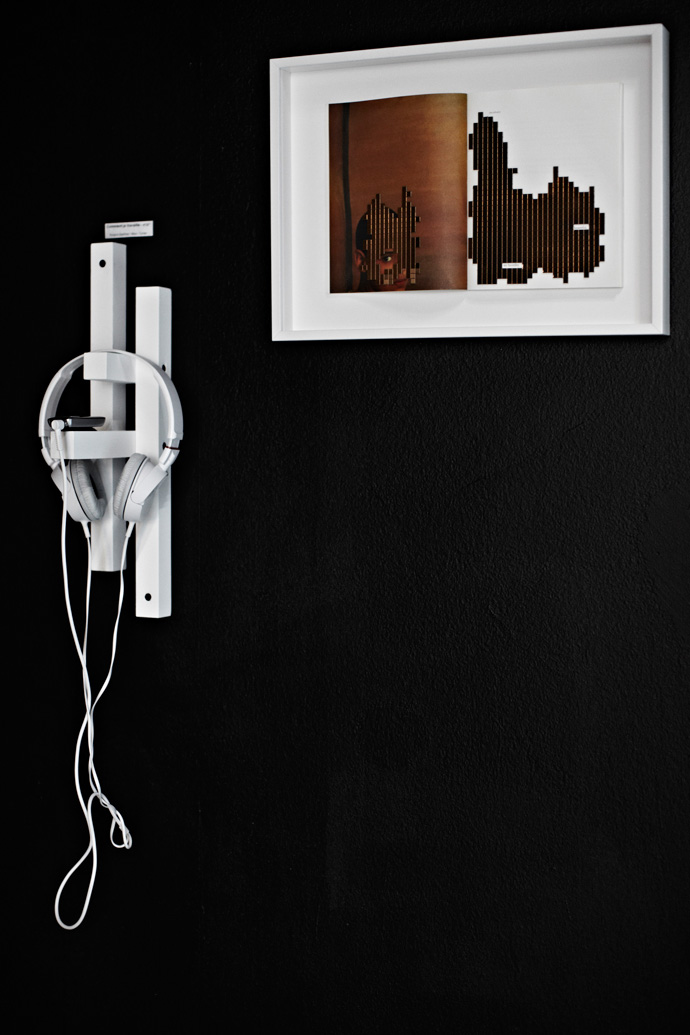
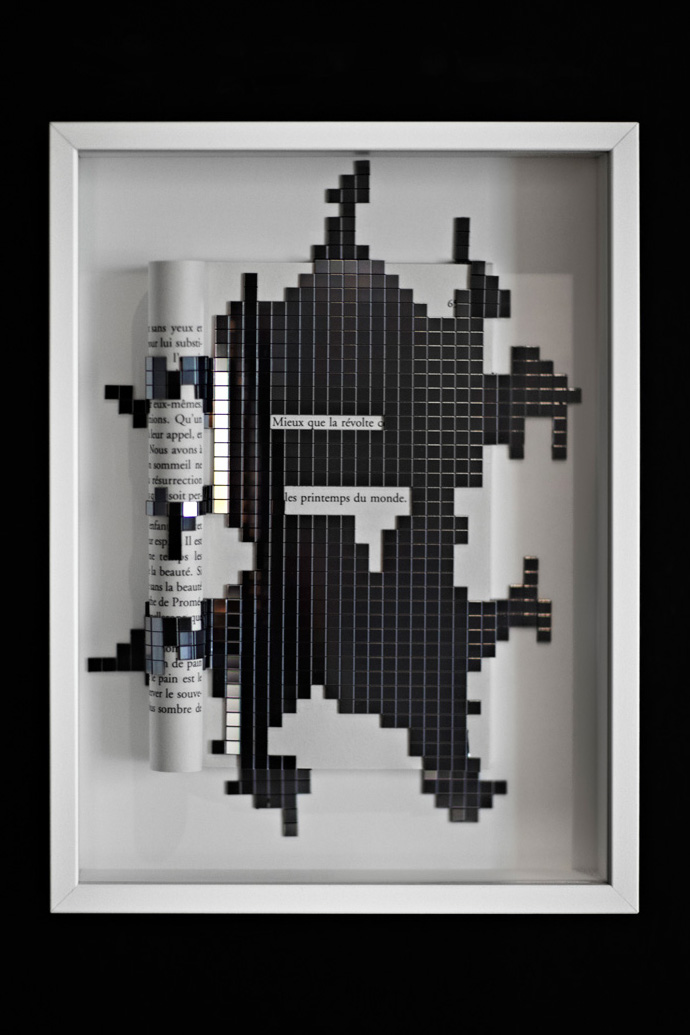 The collage sonore / sound collage installation in room 2. Courtesy Gallery Anne de VillepoixNear the pass to the next room the only book that depicts an image and with this marks the transition to the last complex of works. It’s all about stars and fashion magazines. But now the presentation enhances the fact that the magazines departed from being just the source of material. They become objects themselves, so does the frame and the fixture. It becomes altogether an installation: A cabinet of seven blocks present the works on shelves, hung, or in frames that at times can be turned and reveal a mirror. Mirrors everywhere. “Beyond, beyond, beyond the mirror”, as Patti Smith proclaims earlier in one of the audio collages.
The collage sonore / sound collage installation in room 2. Courtesy Gallery Anne de VillepoixNear the pass to the next room the only book that depicts an image and with this marks the transition to the last complex of works. It’s all about stars and fashion magazines. But now the presentation enhances the fact that the magazines departed from being just the source of material. They become objects themselves, so does the frame and the fixture. It becomes altogether an installation: A cabinet of seven blocks present the works on shelves, hung, or in frames that at times can be turned and reveal a mirror. Mirrors everywhere. “Beyond, beyond, beyond the mirror”, as Patti Smith proclaims earlier in one of the audio collages.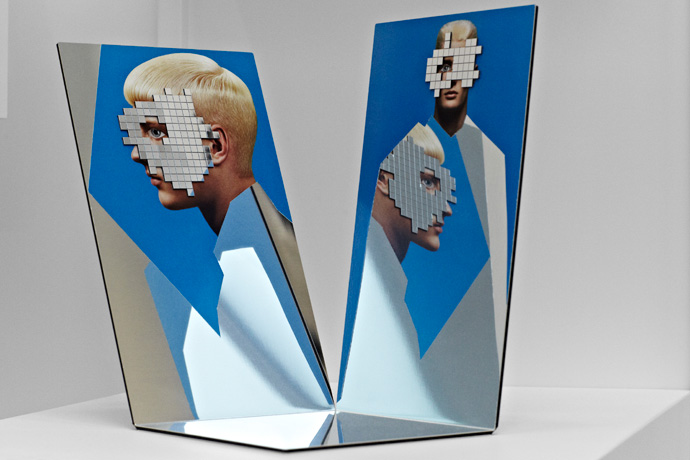 Object in room 3 at Gallery Anne de VillepoixMarc Turlan: EXO STARopening Saturday 10th, running to October 15th 2011at Galerie Anne de Villepoix, rue de Montmorency, 75003 Paris10
Object in room 3 at Gallery Anne de VillepoixMarc Turlan: EXO STARopening Saturday 10th, running to October 15th 2011at Galerie Anne de Villepoix, rue de Montmorency, 75003 Paris10 -

SANDRA BACKLUND: is knitting herself to the top
-Wherever Sandra Backlund picks her thread it will lead to an incomparable result. That earned her the jury prize in Hyères 2008 and with it international recognition, on which Louis Vuitton had bought in shortly after. The dark Swede impresses with knit works that go far beyond the discipline of fashion and render the use of traditional artisan technique to visionary, body oriented sculptures. Looking at her latest installation CUPRUM 2010, it comes not as a surprise she had studied art history.
The Piece made entirely of finest copper yarn, was commissioned by the Villa Noailles for this years exhibition.The Stimuleye talked with Sandra about here recent work. The conversation was shortly interrupted by yet another request from the international glitteratti circuit: Sandra is truly knitting to the top!
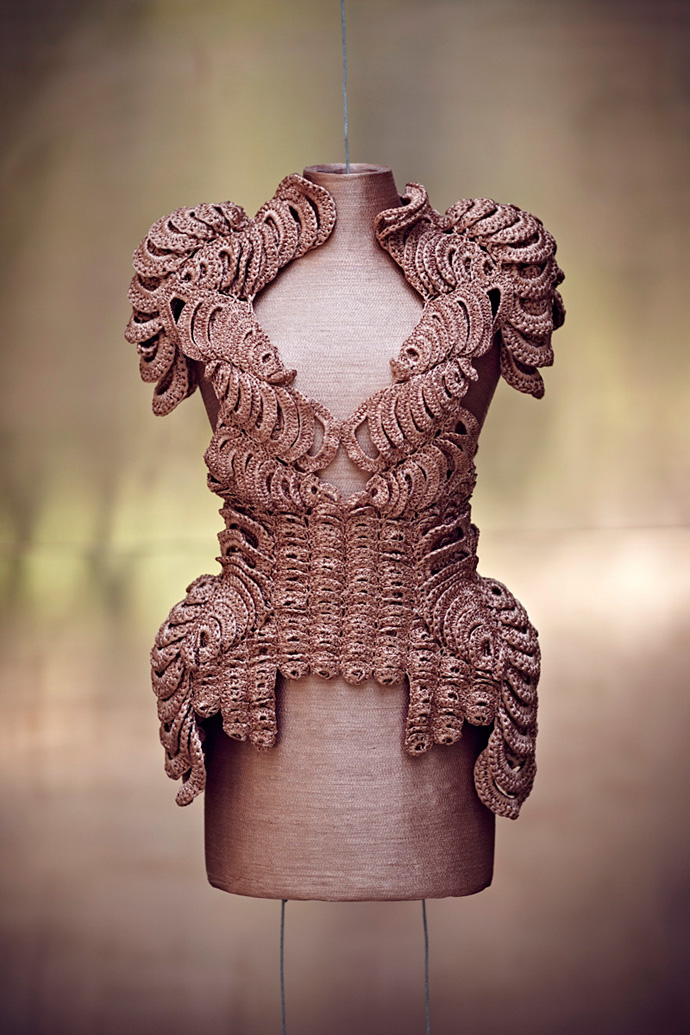 Sandra Backlund's installation CUPRUM 2010 at the Villa Noailles' pigeonnier. Photography by René Habermacher
Sandra Backlund's installation CUPRUM 2010 at the Villa Noailles' pigeonnier. Photography by René HabermacherRENÉ HABERMACHER: What was the point of departure for this installation and the inspiration behind it?
SANDRA BACKLUND: Everything took off from the position they gave me for my exhibition, the Pigeon House in the north garden of Villa Noailles. I think it’s a very beautiful space, so I wanted to use it as a frame, rather then just a location. Because the house is partly open and the exhibition would run for one month outside, I had to carefully consider what material to work with. Already for my current S/S 2011 collection I had been working with a metal yarn made from 100% copper, so in a way it came natural to me to continue exploring that material. With a history of use that is at least 10 000 years old, copper is an important part of both our history and the future. It’s one of the world’s most useful natural resources, 100% recyclable without any loss of quality and it’s estimated that 80% of the copper ever mined, is still in use today. In a way I feel like the story of copper as a material and the way I try to approach fashion go very well together.Can you explain me the process of planning, and the making of the dress?
As always, the handicraft techniques and the human body is the main starting point for me. I never sketch, instead I work with a three dimensional collage method where I develop some basic bricks that I multiply and attach to each other in different ways to discover the silhouette. The only thing I decided already from the beginning was that I wanted some kind of link between the signature piece (the paper origami top) of my winning collection from the 22nd edition of the festival in 2007. Because of the different techniques, materials and colours and because of the process, I guess in the end the link is not so obvious, but there is a few things that is still noticeable, like the silhouette and the size gradings for example.I’ve witnessed you working day and night on this piece – do you have a clue how many hours went into the making?
To be honest, I think that this is the longest piece I have ever worked on. First of all, crochet is always extremely time consuming, especially when it’s layered like this. The copper tape is also very fragile and ones it’s used it, it’s impossible to change, so I had let go of the control and in a way let faith guide me to the end result. If we are talking hours, my estimation is around 500-600 hours.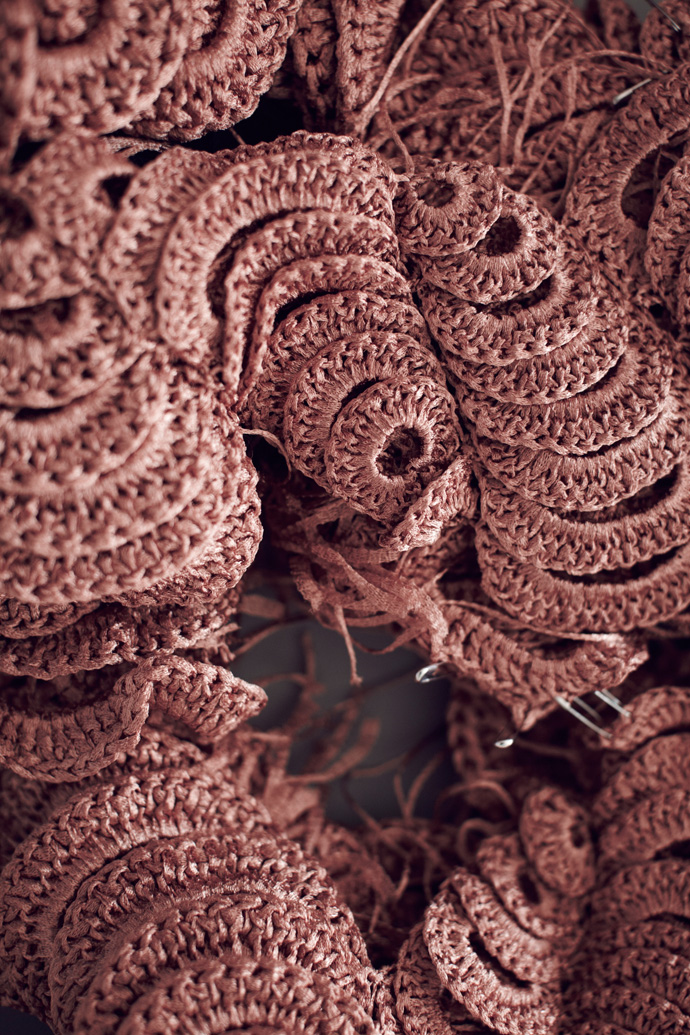
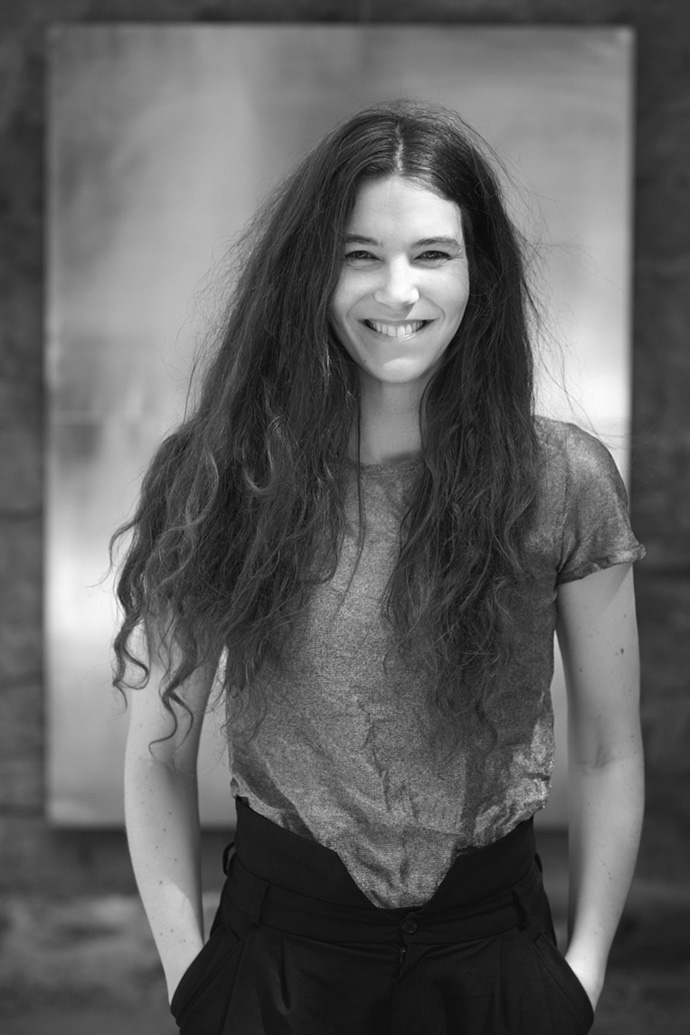 Pieces of copper yarn in the the making, and Sandra at the exhibition space. Photography by René Habermacher
Pieces of copper yarn in the the making, and Sandra at the exhibition space. Photography by René HabermacherYour pieces are often very sculptural, with the artisan work involved, i wonder wether you consider to put your work in a different context than fashion?
Of course I have consider this and many times questioned if fashion is really the right context for my work. As you said, my clothes are always quite sculptural and I also use methods when working that is more close to a sculptor’s, then a tailor’s. But somehow I always come back to the human body. I like to consciously dress and undress different parts of the body and I am very fascinated by all the ways highlight, distort and transform the natural silhouette with clothes and accessories. For me fashion is also one of the most democratic art forms, something that we are all related to. You don’t have to be a designer or a stylist to use clothes as a creative statement, but people in general could of course be more self-governed when t comes to fashion.To me it seems difficult to render your unique approach into industrial production. How are your experiences with that?
About two years ago I was introduced to the long tradition of Italian top knitwear and apparel production. The challenge was to add to my collections something inspired by my hand made pieces that could require only a limited amount of manual work. It was of course a big step for me to go from working alone in my studio, inventing pieces while doing them myself by hand, to suddenly be working in a team of experts within a field of fashion that I never before have had the chance to get to know. I was overwhelmed by all the possibilities I saw and even though I will never give up doing my hand knitted signature pieces, these production tests really made me understand that there is ways to develop my collections that I never thought was possible.What is this festival of Hyères to you? How was it to win – and to be back for this project?
The whole event is really an experience for life when you’re a young designer, all the people you meet and the rush from showing your work in a context like that. I didn’t know about the festival before I met Diane Pernet and she suggested that I should apply. I was crazy happy already when I was selected for the finale and then the wind up… It’s really an important moment in my career so far and to be back again this year and meet everyone was kind of a flash back. When I think about it, I’m still a bit shocked that I was the winner.What’s up next?
F/W 2011-2012 production, S/S 2012 collection and some up coming exhibitions.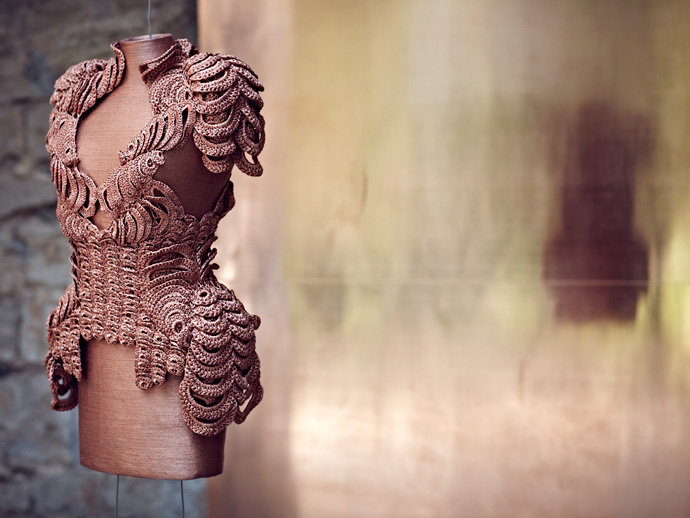
The dress weights over 6kg, made from an archaic material that was the first to be 100% recyclableFurther information on Sandra Backlund: sandrabacklund.com
The Exhibition at the Villa Noailles in Hyeres runs throughout May until the 29th -

NJA MAHDAOUI: strokes of liberation
-Nja Mahdaoui is one of the most celebrated living contemporary artists in the arab world. His bold and highly rhythmic work, derived from the arabic letter, is internationally renowned and can be found in ther permanent collections of the Institut du Monde Arabe, The British Museum and The Smithsonian Institution just to name a few.
It’s an exuberance of arabesque forms, a visual melody played out of his hand, that remind us of the great gestural and physical richness of action painting. Famous for his meticulous inks on parchment, this “liberated calligraphy” is worked across a variety of extremely different surfaces — from canvas, brass, wood, melamine and papyrus to skin. Though It seems like writing, it is not. It is rather an interlacing of a dialectic relationship, also found within Western abstraction.
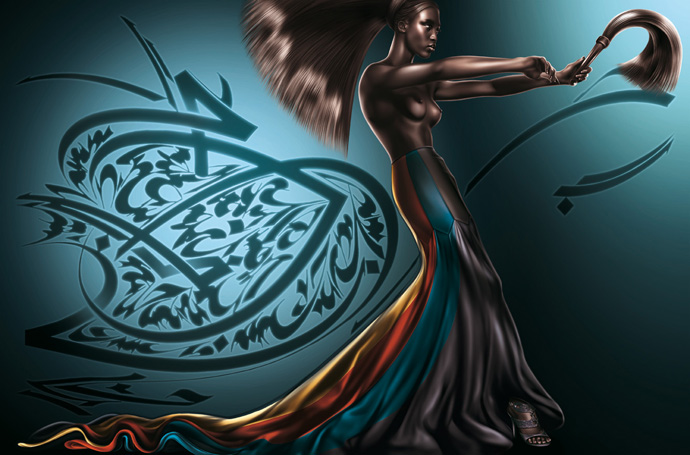 Naomi Campbell in Azzedine Alaïa for Numéro Magazine. A collaboration between Nja Mahdaoui and René Habermacher
Naomi Campbell in Azzedine Alaïa for Numéro Magazine. A collaboration between Nja Mahdaoui and René HabermacherI came across the work of Nja Mahdaoui the first time, while researching calligraphic styles on a project for the French magazine Numéro on a piece about Azzedine Alaïa to which Babeth Djian incited me. The visual impact of Nja’s work struck me at first sight.
Slightly intimidated by the references of the rich body of his work, I first hesitated but then thought to give it a shot, and contacted him. To my surprise he answered me instantly by email, and called me shortly after. Our collaboration was set — and we created a story of imaginary movements around Naomi Campbell as a dark gazelle, in sheer and revealing Alaïa.
But I only met Nja Mahdaoui in person two summers ago in Tunis. It was an all-embracing, hot and sultry August day that lay heavy on the city, matching the emotional state of its people.
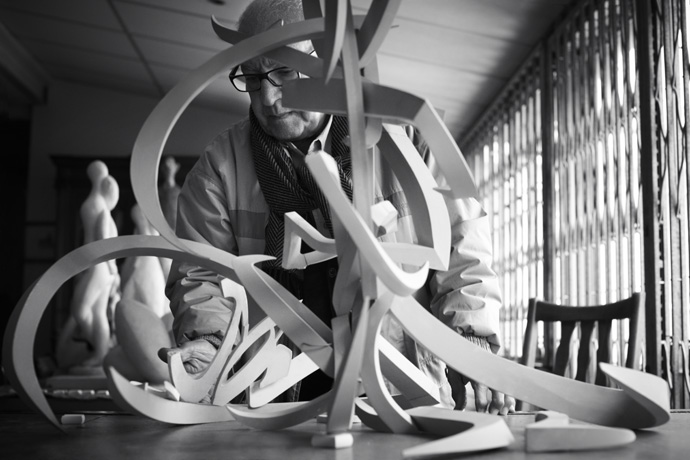 Nja Mahdaoui wit the first prototype of his most recent sculpture. Photography by René Habermacher
Nja Mahdaoui wit the first prototype of his most recent sculpture. Photography by René HabermacherA couple of months after the “Jasmine revolution” took place, Nja arrives in full swing to our meeting at a café in sunny, springtime Paris.
He’d come with his daughter Molka Mahdaoui to work on another of his new projects, yet is consumed with excitement by the events. He reacts immediately and impulsively to the question I usually ask last on conversations for The Stimuleye: What is the last thing that stimulated you?
“Stimulated? You’re asking a Tunisian? (laughs). I don’t know if ‘stimulated’ is the word, but it’s the explosion of a generation, I’m completely into it — for us it’s the event of the century!”
 Nja Mahdaoui: "Graphemes on Arches 2", 2009, Ink on arches paper; 135cm x 135cm.
Nja Mahdaoui: "Graphemes on Arches 2", 2009, Ink on arches paper; 135cm x 135cm.With us at the table are the collaborators involved in the process of making his latest project, a sculpture, the main reason for his trip north. Nja loves collaborations – his eyes glow while he talks energetically about upcoming projects. An energy I felt the first time I saw his bold and highly rhythmic work: “a dance of calligraphy”, with Nja as the choreographer of imaginary letters, to which he refers as ‘graphemes’, devoid of actual textual meaning:
“To a non-Arabic speaker it appears as coherent text. In fact even Arabic speakers assume at first that it’s a text with meaning. But when they start reading it they realise it is not an actual word.” he says and recalls an experience:
“It is not easy to write letters in a disjointed way — that is disjointed to not mean anything — and focus only on the aesthetic. There was a study at the California Institute of Technology in Pasadena. They connected me to a machine in order to test the levels of stress my body was under when I was writing proper words and when I was writing words without meaning. The study showed that my body was 2.5 times more stressed when I was working on words without meaning. So it is a very conscious attempt to create art. I tell people I’m not a calligrapher, but an artist.”
To me his body of work is so vibrant and remarkably innovative that I first had assumed Nja to be in his early 30’s the most, yet he was born in La Marsa, Tunisia, in 1937. As Molka, a filmmaker herself, puts it during our conversation: “sometimes i have to remind myself: Molka, you are thinking older than your own father!”.
 Nja Mahdaoui: Design for Gulf Air 50th Anniversary. Image Courtesy of Nja Mahdaoui
Nja Mahdaoui: Design for Gulf Air 50th Anniversary. Image Courtesy of Nja Mahdaoui -

REIN VOLLENGA talks to FILEP MOTWARY
-An artist or a milliner, a sculptor or a fashion creative, Rein Vollenga is a true artist, teetering between both fields with optimistic and unconditional inspiration.
Ever since he first revealed his works to the public back in 2007, Dutch Vollenga’s career seems unstoppable, counting numerous collaborations with the likes of Lady Gaga, MUGLER, Johnny Woo, Marcel Fengler, Mc Kinki, Tiga…
The interview is an exclusive in participation of The Stimuleye with uN nouVeau iDEAL
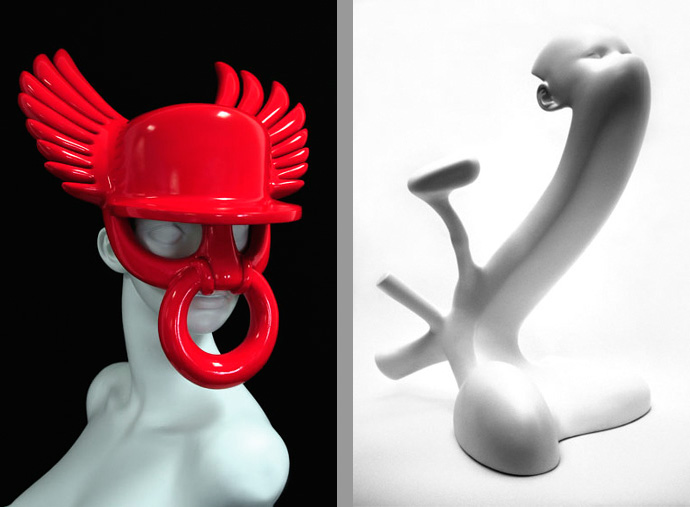 REIN VOLLENGA: Headpiece Hip-Hop Tribe, 2010, Mixed Media and Untitled, 2007, Mixed Media
REIN VOLLENGA: Headpiece Hip-Hop Tribe, 2010, Mixed Media and Untitled, 2007, Mixed MediaHis works have been triumphantly presented in the most prestigious publications like Italian Vogue, Interview Magazine, Dazed, i-D, Vman as well as was featured in notorious web links like ShowStudio, Style.com and The New York Times not to mention Museums like Neues.
Two days before the opening night featuring his participation at “I WANNA DANCE WITH SOMEBODY” (a project headed by Lars Laumann presented at The Hague’s West Gallery) I had a chat with him for The Stimuleye. Lets dive in our conversation at the moment I was trying to explain the dramatic changes Greece is going through…
FILEP MOTWARY: So, yes back to drama….
REIN VOLLENGA: Drama is always a good source for making art.
FilepMotwary: How does drama reflect in your work then? The forms you create are not happy yet neither sad. But there is always some kind of expression in them that leads one to wonder what the situation behind those faces is about…
ReinVollenga: My work is never a reference to just one specific thought, but if I can somehow invoke emotion, make people think or stimulate and inspire somebody then I’m happy.
I don’t want to teach or force people to learn something, as Art is a really personal experience, a fantasy or illusion. Artists should treasure that and exclude their own vanity in spite of excluding the viewer. I feel I don’t need to change the world either, neither can I.
I can only interact or have a dialogue with the viewer through what I create. I would love to change the world but it doesn’t make sense, forcing people to believe in something they don’t understand.
In my sculptures I like to attract the viewer through the beauty reflected in them. By looking closely at the piece, it will reveal by itself, something that might not be so pleasant at the end. This is the kind of contrast I like!
FilepMotwary: I like your way of thinking. Yohji Yamamoto once stated, “‘an artist is somebody who creates things that you don’t need’.” How do you see art?
Rein Vollenga: Art to me is an experience, Illusion or fantasy. It’s something that triggers your mind and keep you fantasizing.
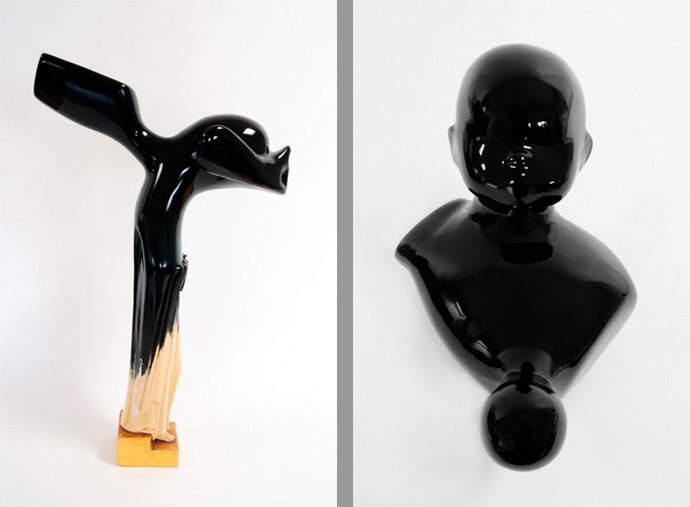 REIN VOLLENGA: Untitled, 2008, Mixed Media and Untitled, 2007, Mixed Media
REIN VOLLENGA: Untitled, 2008, Mixed Media and Untitled, 2007, Mixed Media
(more…) -

